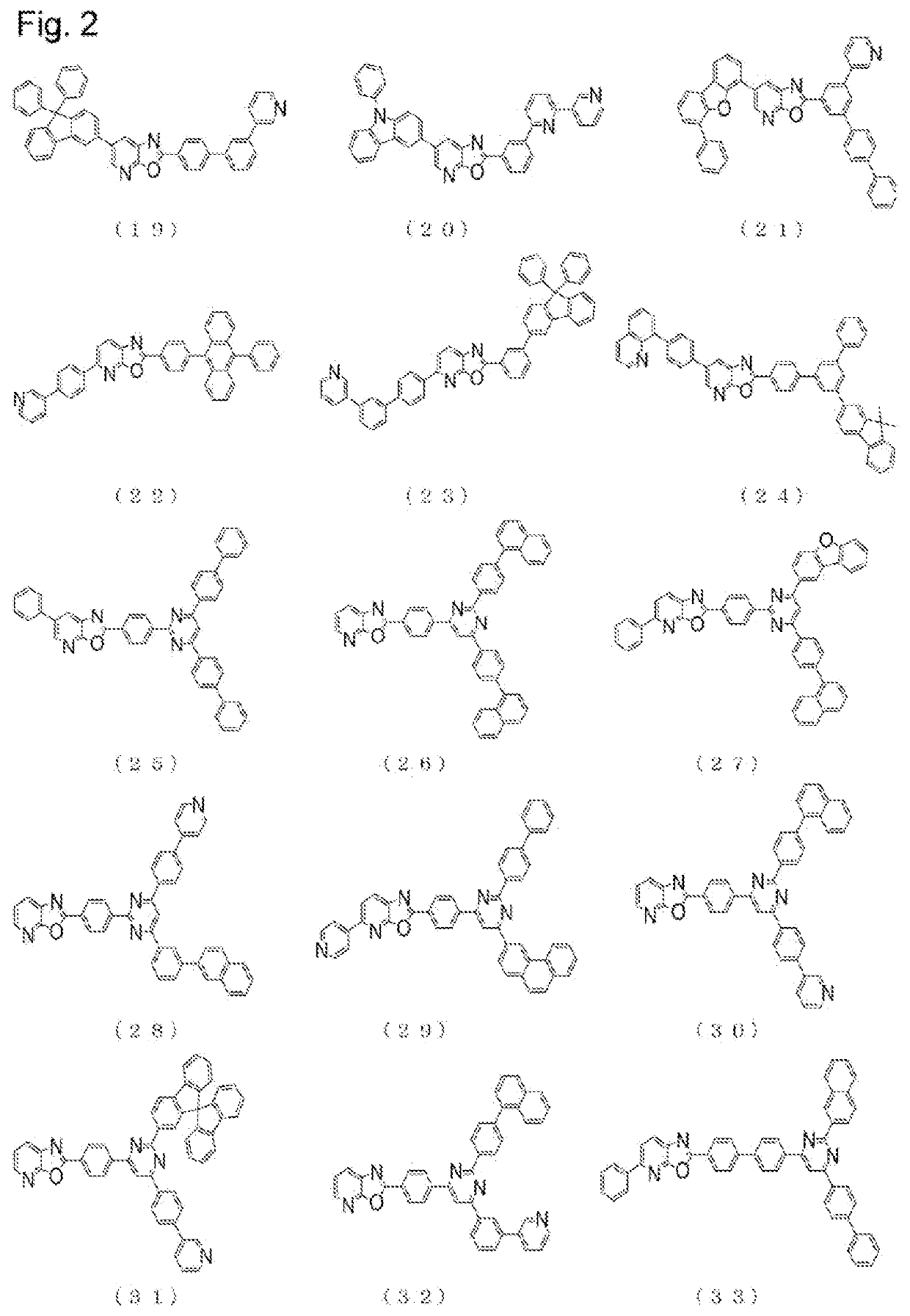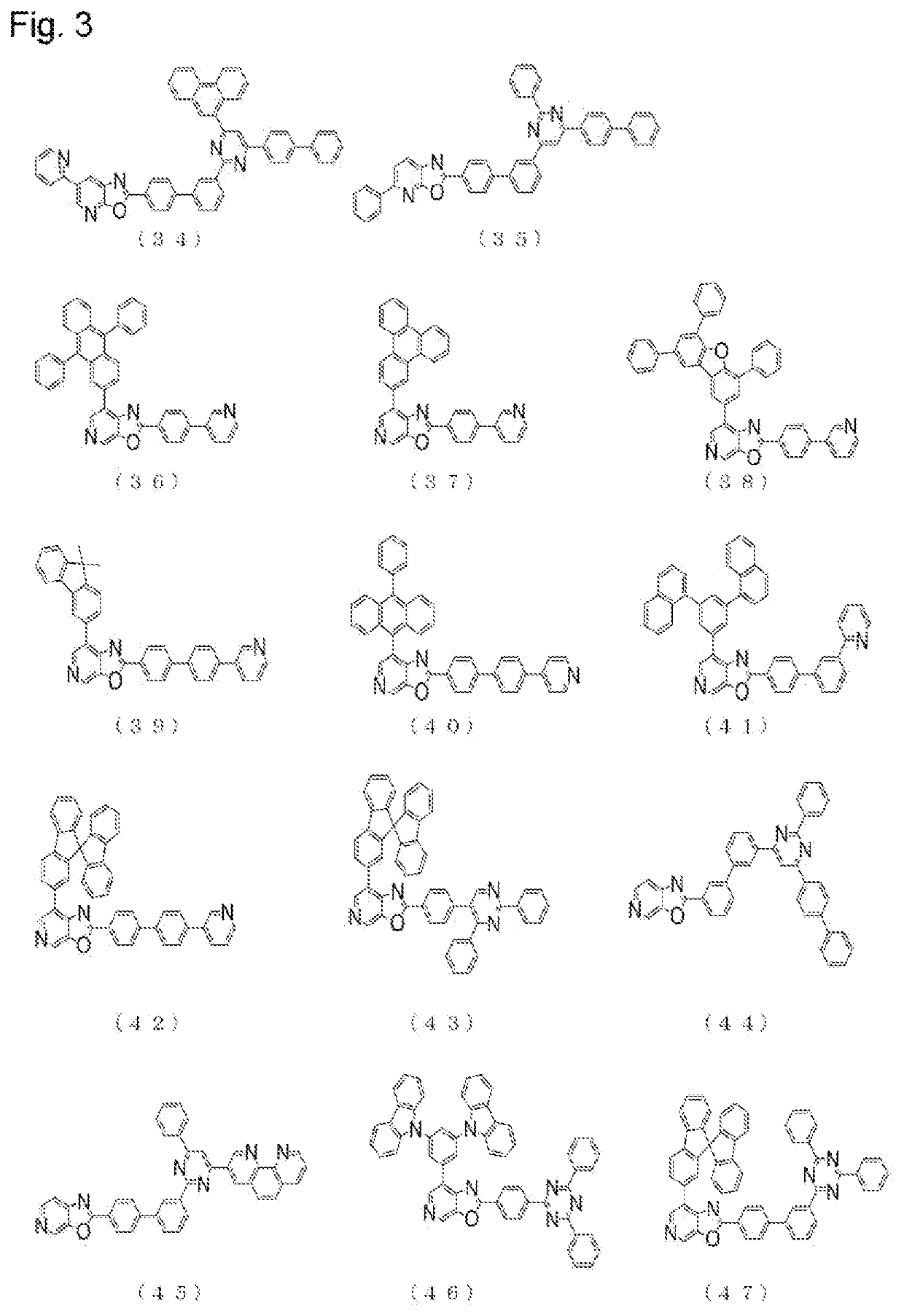Compound having azabenzoxazole ring structure and organic electroluminescent element
- Summary
- Abstract
- Description
- Claims
- Application Information
AI Technical Summary
Benefits of technology
Problems solved by technology
Method used
Image
Examples
example 1
Synthesis of 6-(10-phenyl-anthracene-9-yl)-2-(4-pyridine-3-yl-phenyl)-7-azabenzoxazole (Compound (5))
[0120]First, 4.1 g of 2-(4-chlorophenyl)-6-(10-phenyl-anthracene-9-yl)-7-azabenzoxazole, 1.1 g of 3-pyridylboronic acid, 0.6 g of tris(dibenzylideneacetone)dipalladium(0), 1.0 ml of 50% (w / v) tri-(t-butyl)phosphine solution in toluene, and 5.2 g of cesium carbonate were placed in a reaction vessel, and stirred under reflux overnight in a 1,4-dioxane / H2O mixed solvent. The reaction system was allowed to cool. Then, ethyl acetate / H2O was added thereto, and an organic layer was obtained through extraction and separation, and concentrated to obtain a crude product. The thus obtained crude product was purified by column chromatography (carrier: silica gel, eluent: dichloromethane / ethyl acetate) to thereby obtain 3.2 g (yield: 71%) of a pale yellow powder of 6-(10-phenyl-anthracene-9-yl)-2-(4-pyridine-3-yl-phenyl)-7-azabenzoxazole (Compound (5)).
[0121]The structure of the obtained pale yel...
example 2
Synthesis of 2-{4′-(pyridine-3-yl)-biphenyl-4-yl}-6-(9,9′-spirobi[9H]fluorene-2-yl)-7-azabenzoxazole (Compound (15))
[0123]First, 10.0 g of 2-(4-chlorophenyl)-6-(9,9′-spirobi[9H]fluorene-2-yl)-7-azabenzoxazole, 4.4 g of 4-(pyridine-3-yl)-phenylboronic acid, 0.5 g of tris(dibenzylideneacetone)dipalladium(0), 0.3 g of tricyclohexylphosphine, and 11.7 g of tripotassium phosphate were placed in a reaction vessel, and stirred under reflux overnight in a 1,4-dioxane / H2O mixed solvent. The reaction system was allowed to cool. Then, ethyl acetate / H2O was added thereto, and an organic layer was obtained through extraction and separation, and concentrated to obtain a crude product. The thus obtained crude product was purified by column chromatography (carrier: silica gel, eluent: dichloromethane / ethyl acetate) to thereby obtain 8.7 g (yield: 71%) of a pale yellow powder of 2-{4′-(pyridine-3-yl)-biphenyl-4-yl}-6-(9,9′-spirobi[9H]fluorene-2-yl)-7-azabenzoxazole (Compound (15)).
[0124]The structur...
example 3
Synthesis of 2-{3′-(pyridine-3-yl)-biphenyl-4-yl}-spirobi[9H]fluorene-2-yl)-7-azabenzoxazole (Compound (17))
[0127]First, 10.0 g of 2-(4-chlorophenyl)-6-(9,9′-spirobi[9H]fluorene-2-yl)-7-azabenzoxazole, 4.4 g of 3-(pyridine-3-yl)-phenylboronic acid, 0.5 g of tris(dibenzylideneacetone)dipalladium(0), 0.3 g of tricyclohexylphosphine, 11.7 g of tripotassium phosphate were placed in a reaction vessel, and stirred under reflux overnight in a 1,4-dioxane / H2O mixed solvent. The reaction system was allowed to cool. Then, ethyl acetate / H2O was added thereto, and an organic layer was obtained through extraction and separation, and concentrated to obtain a crude product. The thus obtained crude product was purified by column chromatography (carrier: silica gel, eluent: dichloromethane / ethyl acetate) to thereby obtain 8.3 g (yield: 68%) of a pale yellow powder of 2-{3′-(pyridine-3-yl)-biphenyl-4-yl}-spirobi[9H]fluorene-2-yl)-7-azabenzoxazole (Compound (17)).
[0128]The structure of the obtained pa...
PUM
 Login to View More
Login to View More Abstract
Description
Claims
Application Information
 Login to View More
Login to View More - R&D
- Intellectual Property
- Life Sciences
- Materials
- Tech Scout
- Unparalleled Data Quality
- Higher Quality Content
- 60% Fewer Hallucinations
Browse by: Latest US Patents, China's latest patents, Technical Efficacy Thesaurus, Application Domain, Technology Topic, Popular Technical Reports.
© 2025 PatSnap. All rights reserved.Legal|Privacy policy|Modern Slavery Act Transparency Statement|Sitemap|About US| Contact US: help@patsnap.com



